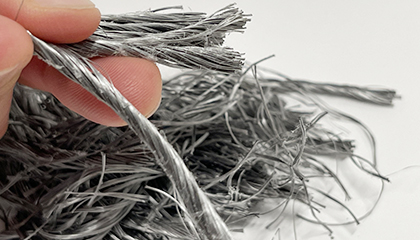The use of polypropylene fiber in cement screeds and concrete mixes allows you to get a lot of additional advantages compared to the use of a conventional steel reinforcement frame. The fiber significantly reduces cracking at the early stage of shrinkage, while the steel reinforcement frame works to reduce the development of shrinkage cracks on the screed surface and the content of material with cracks that have already appeared. That is, the steel mesh works only when the screed has already cracked.
How to prevent cracking in the early stages of concrete solidification?
Why do I need to use polypropylene fiber?
Polypropylene fiber serves as a micro-reinforcement of concrete in order to minimize the number of microcracks (>95%) that appear at the initial stages of concrete solidification. Moisture absorption is reduced by 33-44% and water release is reduced by effective hydration control. Due to the control of the water protrusion on the surface, the formation of cracks during plastic subsidence is reduced, thereby reducing the internal load. Fiber is used to increase resistance to low temperatures, since polypropylene fiber introduces a small amount of air into the concrete and reduces the number of water channels in the concrete, which allows free water to expand and contract in the freezing –thawing cycle. Concrete containing fiber has significantly greater impact resistance and resistance to splitting compared to conventional concrete. Fiber prevents damage to the edges of joints in concrete slabs and precast concrete structures, on various concrete surfaces, ribs and corners, reduces damage when removing the formwork.
 What is the scope of polypropylene fiber?
What is the scope of polypropylene fiber?
- Industrial construction, industrial floors;
- Private construction – foundations, plasters, mortars, screeds;
- Road construction – bridges, overpasses, road surface;
- Hydraulic engineering construction – embankments, breakwaters, marine protective structures;
- Underground construction – tunnels, metro;
- Foam concrete and other cellular concrete;
- Mine structure;
- Shotcrete;
- Production of piles;
- Stamped concrete;
- Parapets and paving slabs;
- Concrete slabs, pipes, blocks, etc.
 Is it possible to use polypropylene fiber and Polyex Mesh polymer fiber at the same time?
Is it possible to use polypropylene fiber and Polyex Mesh polymer fiber at the same time?
To prevent the occurrence of both macro- and microcracks, it is recommended to use two types of fiber at once. The best option would be to use 1.5 kg of Polyex Mesh polymer fiber for concrete reinforcement and 1 kg of polypropylene fiber for micro-reinforcement from cracking per 1 m3 of concrete solution. Polypropylene fiber begins to work to prevent cracking at the early stages of concrete setting, whereas synthetic polymer fiber Polyex Mesh is reinforcing at later stages, up to the complete setting of concrete for up to 28 days and in the further operation of the concrete structure.
The greatest destructive force is caused by deformations that occur over time in concrete structures. Processes associated with bending and stretching loads, internal stresses during cyclic freezing and thawing, environmental influences and corrosion processes significantly affect the condition of the structure. By adding various types of fiber to concrete mixes, it is possible to prevent or significantly reduce the influence of these factors on the concrete structure.

